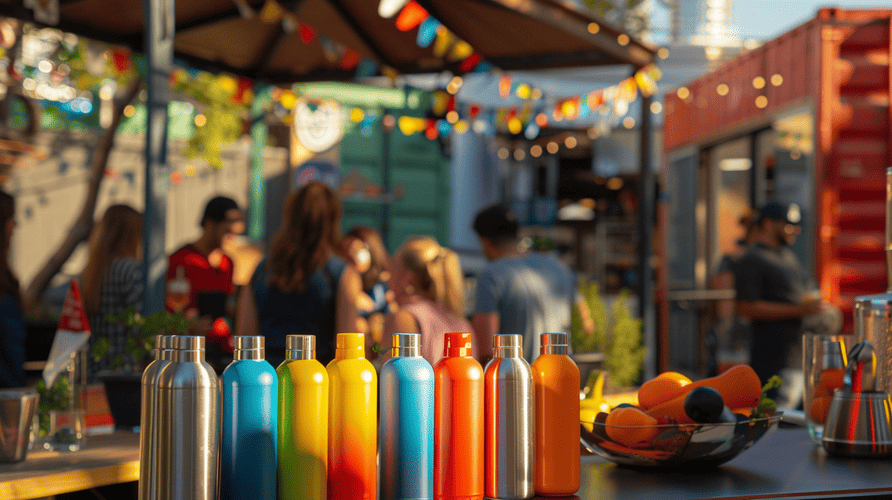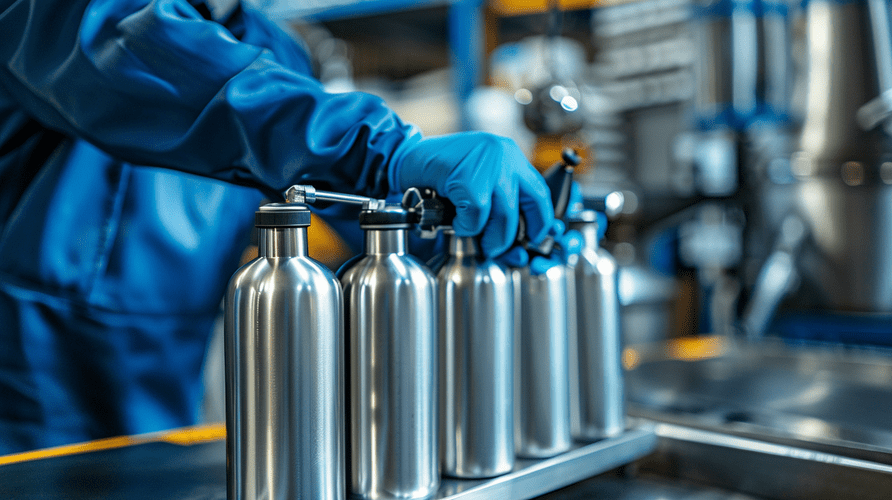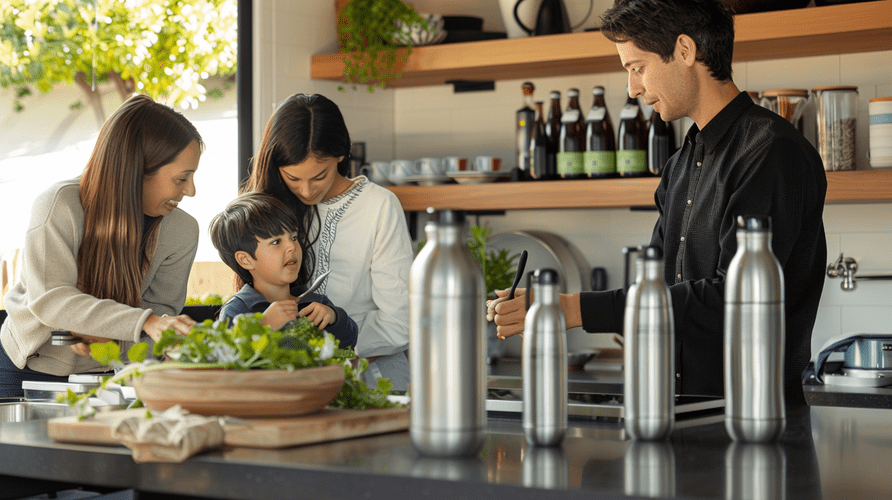Choosing the right insulated bottle can feel overwhelming. Make the wrong choice, and you risk unhappy customers or wasted inventory. Let me guide you through the key factors for 2025.
The top insulated water bottle picks for 2025 emphasize sustainability, smart features, and enhanced personalization. Food-grade stainless steel remains the safest material. Key safety and performance features include reliable vacuum insulation, leak-proof lids, and non-toxic, durable finishes.

Selecting the right insulated water bottles is crucial for businesses like yours, maybe like Mark Shenng in Canada who needs top quality at good prices. You need products that sell well, meet safety standards, and reflect well on your brand. Staying ahead of trends, understanding materials, and focusing on essential features is key to making profitable purchasing decisions. Let's break down what you need to know for 2025.
What is the trend in water bottles in 2025?
Falling behind market trends means losing sales. Your competitors might offer newer styles or features, leaving your stock outdated. Let's look at what customers will want in 2025.
In 2025, the main trends are eco-friendly materials1 (like recycled steel), smart bottles that track hydration, bold colors and customization options, and improved insulation technology for even longer temperature retention.

Staying current is vital in the fast-moving drinkware market. For buyers like Mark, offering trendy products alongside classic ones can capture a wider audience. Let's explore these trends more.
Eco-Conscious Choices
Sustainability isn't just a buzzword; it's a core customer demand. In 2025, expect growth in bottles made from recycled stainless steel or incorporating other sustainable elements. Some brands might explore bio-plastics for lids or accessories, though stainless steel remains dominant for the body due to its durability and safety. At Icobottle, we are already exploring options for using certified recycled stainless steel to meet this growing demand, ensuring quality isn't compromised. This resonates with buyers looking for responsible sourcing.
Smart Technology Integration
Smart water bottles are moving beyond novelty. Features like hydration tracking via sensors, reminders to drink through connected apps, and even water purification systems (like UV-C LEDs in the lid) will become more common. While potentially adding cost, these features appeal to health-conscious consumers and tech enthusiasts. We are watching this space closely to integrate proven, reliable tech features when they align with our B2B clients' needs for robust, functional products.
Bold Personalization and Design
Customization remains king. Beyond logos, expect demand for unique color combinations, finishes (like gradients or textures), and even slightly different shapes. Limited edition runs with artists or designers might also trend. For wholesale buyers, offering a wide range of customization possibilities is essential. We pride ourselves on flexible customization, from Pantone color matching to intricate logo applications, ensuring your brand stands out.
| Trend | Key Aspect | Benefit for Your Business | Icobottle's Approach |
|---|---|---|---|
| Eco-Friendly | Recycled materials, less plastic | Meets consumer demand, enhances brand image | Exploring certified recycled steel options |
| Smart Bottles | Hydration tracking, app sync | Appeals to tech/health niche, premium item | Monitoring tech maturity for reliable integration |
| Personalization/Design | Unique colors, finishes, logos | Stronger brand identity, higher perceived value | Extensive Pantone matching, various logo methods |
| Enhanced Insulation | Longer hot/cold retention | Core performance expectation, customer loyalty | Continuous improvement of vacuum seal technology |
Understanding these trends helps you curate a product selection that excites customers and drives sales in 2025.
What are the safest materials for water bottles?
Using bottles made from unsafe materials risks your customers' health and your brand's reputation. Negative reviews or even recalls can be damaging. Let's focus on the safest choices.
Food-grade stainless steel, specifically 18/8 (or grade 304), is widely considered the safest and most durable material for water bottles. It doesn't leach chemicals, rust, or retain flavors. BPA-free plastics2 are secondary options, but steel remains superior.

Material safety is non-negotiable, especially when importing products. For someone like Mark, who prioritizes quality and deals with international suppliers, ensuring material safety and proper certification is paramount. Let’s examine the materials more closely.
Stainless Steel: The Gold Standard
Why 18/8 (304)? This specific grade contains 18% chromium and 8% nickel. Chromium provides rust resistance, while nickel enhances durability and formability. This combination is stable, meaning it won't react with beverages (acidic or alkaline) or leach harmful substances like BPA or phthalates, which can be concerns with some plastics. It’s also incredibly tough, resisting dents and drops better than glass or aluminum. We exclusively use high-quality 18/8 stainless steel3 in Icobottle products to guarantee safety and longevity.
Other Material Considerations
- BPA-Free Plastics (e.g., Tritan): Often used for lids or sometimes bottle bodies. While certified BPA-free plastics are safer than older plastics, concerns sometimes linger about other potential leaching chemicals, especially over time or with heat exposure. They are lighter but less durable than steel and may retain odors or stains.
- Glass: Inert and safe, offering pure taste. However, it's heavy and fragile, making it less practical for everyday carry, especially in insulated designs where it's often an inner layer protected by an outer one.
- Aluminum: Often requires an inner lining (plastic or epoxy resin) to prevent reaction with liquids, which can be a source of potential chemical leaching (e.g., BPA in older liners) and can get damaged. Not as durable or inert as stainless steel.
Importance of Certifications
For B2B buyers, verifying material safety is crucial. Look for suppliers who can provide legitimate certifications like FDA (US Food and Drug Administration) approval or LFGB (German Food Commodity and Feed Law) compliance. These tests confirm the material is safe for food contact. Mark’s past issues with certificate fraud highlight the need to work with reputable suppliers like us who provide transparent documentation.
| Material | Safety | Durability | Insulation Capability | Notes |
|---|---|---|---|---|
| 18/8 Stainless Steel | Excellent (Inert, no leaching) | High | Excellent (with vacuum) | Best overall choice, recyclable |
| BPA-Free Plastic | Good (if certified) | Medium | Poor (unless insulated) | Lighter, potential long-term concerns |
| Glass | Excellent (Inert) | Low | Good (if double-walled) | Heavy, breakable |
| Aluminum | Depends on lining | Medium | Fair (often single-wall) | Needs lining, less durable than steel |
Choosing 18/8 stainless steel provides the best combination of safety, durability, and performance for insulated water bottles.
What are the features of insulated bottles?
Not all insulated bottles keep drinks hot or cold effectively. Poor performance leads to customer dissatisfaction and complaints about lukewarm coffee or melted ice. Know the essential features.
Key features include double-wall vacuum insulation for temperature control, leak-proof lids4 (screw-on, flip-top, straw), durable exterior coatings5 (like powder coating), and often a wide mouth for easy cleaning and adding ice.

Understanding the features that contribute to a high-quality insulated bottle is essential for procurement. For Mark, ensuring the bottles he sources perform as expected is vital for his brand's premium positioning. Let's dive into these features.
The Magic of Vacuum Insulation
This is the core technology. An insulated bottle has two walls of stainless steel (an inner and an outer wall). The air between these walls is pumped out during manufacturing, creating a near-vacuum. Because there are very few molecules in this vacuum space, heat transfer (whether heat getting in or out) is drastically reduced. This is why good insulated bottles can keep drinks hot for 12+ hours or cold for 24+ hours. The quality of the vacuum seal is critical; a poor seal compromises performance significantly. At Icobottle, we rigorously test our vacuum insulation process.
Lid Design and Functionality
The lid is often the weakest point for both insulation and leaks.
- Leak-Proof Seals: Look for silicone gaskets or O-rings that create a tight seal.
- Lid Types:
- Screw-on: Simple, often offers the best seal, but requires two hands.
- Flip-Top: Convenient for one-handed drinking, but the mechanism needs to be durable and seal well.
- Straw Lid: Easy sipping, popular for cold drinks, but can be harder to clean and sometimes less insulated.
- Spout Lid: Good for controlled pouring or gulping.
The best lid choice depends on the intended use. Offering interchangeable lids can be a great selling point.
Durability and Handling
- Exterior Finish: Powder coating is a popular choice. It's more durable than simple paint, resists scratches and chips, and provides a slightly textured grip. Other options include brushed stainless steel or specialized textured finishes.
- Base: Some bottles have a silicone base for added stability and protection against dents.
- Shape: Ergonomic shapes or handles can improve handling, especially for larger bottles. A wide mouth opening makes it easier to add ice cubes and clean the inside thoroughly.
| Feature | Purpose | Key Benefit for End User | What to Look For |
|---|---|---|---|
| Vacuum Insulation | Minimize heat transfer | Keeps drinks hot/cold for extended hours | Double-wall construction, proven performance data |
| Leak-Proof Lid | Prevent spills | Confidence carrying in bags | Quality silicone seals, secure closure mechanism |
| Durable Exterior | Resist scratches, dents, wear | Longer product life, maintains appearance | Powder coating, quality stainless steel |
| Wide Mouth Opening | Easy filling and cleaning | Convenience, better hygiene | Opening large enough for ice cubes/brush |
| Appropriate Lid Type | Match drinking style (sip, gulp, straw) | Ease of use | Secure fit, durable mechanism, easy to clean |
Focusing on these core features ensures you source high-performing, reliable insulated bottles that customers will appreciate.
Conclusion
For 2025, focus on sustainable trends, prioritize 18/8 stainless steel for safety, and ensure key features like vacuum insulation and leak-proof lids are top-quality. This ensures satisfied customers.
-
Explore how eco-friendly materials can enhance your product offerings and meet consumer demand for sustainability. ↩
-
Learn more about BPA-free plastics and their safety concerns, helping you make informed choices for your water bottle materials. ↩
-
Explore this link to understand the benefits of 18/8 stainless steel, the safest choice for water bottles, ensuring health and durability. ↩
-
Discover the importance of leak-proof lids in preventing spills and maintaining the quality of your beverages while on the go. ↩
-
Learn about various durable exterior coatings that enhance the longevity and appearance of insulated bottles, making them a worthwhile investment. ↩

